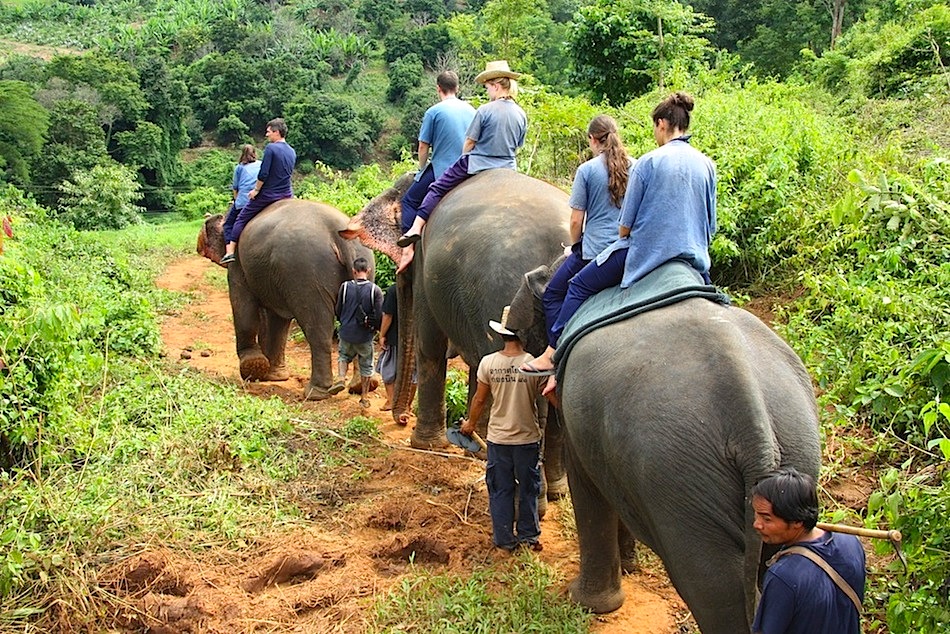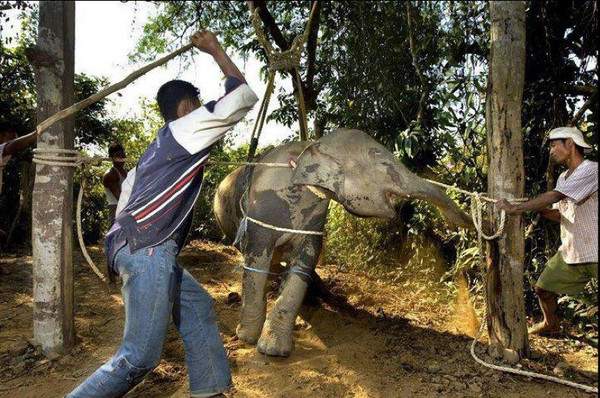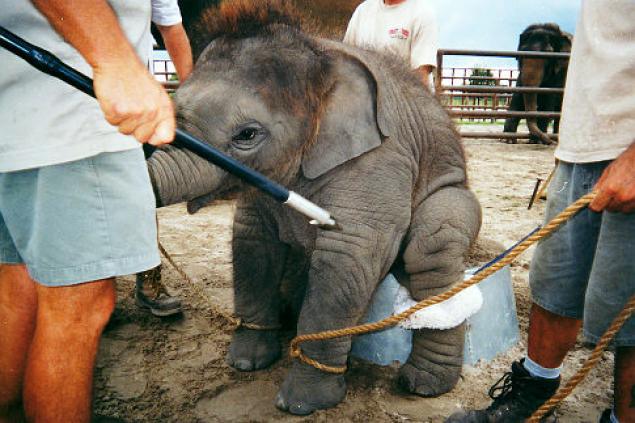Five secret horrors of elephant tourism in Thailand

The number of elephants used in tourism has increased over the last decade, as people continue to include elephant riding as a ‘must do’ item on their bucket list. As demand is increasing, more and more elephants are being kidnapped from the wild and smuggled across borders so they can be trained for the tourism industry.
It originated in Asia when elephant logging was banned and mahouts turned to tourists to earn money for themselves and their elephants; but now, elephant safaris are spreading to Africa and larger, more unpredictable African elephants are being used for tourism as well.
Today between 100 to 250 baby elephants are smuggled from the wild each year. That's about two to three a week.
Poachers anaesthetise the baby elephant and shoot the adult elephants who linger as the baby collapses. The poachers do not have time to take the tusks, trunk and sexual organs of the dead elephants. ''The baby elephant may wake up, the neighbours who have heard gun shots may arrive, or other elephants may return and attack.''
The baby elephants are then sold to ''middlemen'' who torture and tame the animals in safe houses for a week before selling them to tourism operators for a profit of up to 500,000 baht. Within nine years, the tourist camps are able to register these elephants as offspring of captive mother elephants, and no further questions are asked."
For elephants being tranferred over the boarders, it is done in compliance with corrupt politicians, government officials and influential businessmen....[Regional problem!!!] ...The “Authorites” are littered with corrupt individuals who are constantly being caught out.
While it can’t be denied that the income from tourism is necessary for many poor mahouts, it is seriously harmful to the elephant’s welfare and there are alternatives which could provide other sources of income. Some critics argue that if elephants are rescued and can’t be released, tourism is the only alternative rather than zoos or circuses – but they are unlikely to be treated any better just because they are more economically valuable. In fact, they are more likely to be overworked by their owners.
Crushing the spirit: the phajaan
Elephant tourism often involves riding on an elephant’s back, which is usually presented either as a way to ‘get up close to an elephant’ or as a method of travelling through the jungle to spot other wildlife. While this may appear at first glance to be safe and harmless for the elephant, in reality this couldn’t be further from the truth.
In order to be suitable for riding, Asian elephants must be trained whilst young via a traditional process called the ‘phajaan’ or crush. This involves each elephant being trapped in a tiny space whilst being abused with bull hooks and bamboo sticks spiked with nails, as well as starved, deprived of sleep and worse, in order to make them so fearful of humans that they will do anything to avoid being hurt again. Half of all elephants which undergo the phajaan will die during the days of torture they undergo, and of those that survive, many will become very aggressive and could kill their mahouts who train and ride them.
There are many videos of this horrific process on YouTube, such as then one below, this is distressing to watch, but it must be so much worse for the elephant to endure. There are other less harmful ways to train elephants if it was genuinely necessary – for example if you were training an elephant to accept veterinary treatment in a sanctuary before it was re-released.
Positive reinforcement methods could be used which are just as effective as punishment and much less painful and stressful for the elephant (Fagen et al 2014). There have been some reports of African elephants being trained for safaris using positive methods, but no studies have been carried out yet to examine how effective these are.
Elephant Trekking
Unfortunately this is only the beginning, as the elephants will now probably spend the rest of their lives giving rides to tourists every single day. The saddles which the tourists ride on are heavy and can often cause long term damage to their spines, as well as skin sores due to the constant rubbing and foot infections. In the wild, elephants would spend up to 18 hours each day foraging for food, but in captivity they are often forced to give rides all day without many breaks for rest or food.
You can read more about the welfare problems with elephant trekking here, but in short it is a poorly governed, profit based industry with nothing to monitor or regulate the welfare of the elephants. It is also dangerous for the mahouts or keepers, as the elephants (especially bulls) are often aggressive after undergoing the phajaan training and the mahouts have no way of protecting themselves against an enraged 3000kg elephant. Sadly, many of these deaths go unreported as mahouts are considered to belong to a lower caste in Asia.
Elephants being used in festivals
Other examples of elephants being used as part of the tourist industry include the use of elephants in processions and festivals. For example, the yearly Surin Elephant Round-up in Thailand involves nearly 100 elephants which have been trained to play football, perform dances and give rides. These elephants can come from all around Thailand.
While the transport process itself can be very stressful to the elephants, the main danger to their welfare comes from the noise of the crowds, and the bullhooks that are used to force them to perform the correct behaviours. Research has shown that elephants which are used in public processions have significantly higher stress levels than those which are kept in zoos (Kumar et al 2014), suggesting that the use of elephants in festivals should be reduced as much as possible to try and safeguard their welfare.
Danger to tourists
Another issue with using elephants in tourism is the risk it poses to the tourists themselves; tourists sitting on the back of an elephant have no safety equipment to protect them should they fall off or be trampled on. There have been several reports over the years of tourists being injured whilst riding an elephant on safari. – like this report from 2011.
Disease
Additionally, tourists who come into close contact with elephants could contract zoonotic diseases (illnesses which can be passed between humans and animals), such as tuberculosis.
Several scientific studies have examined the rate of TB transmission between humans and elephants. This is usually more common among keepers and mahouts who have daily contact with their elephants, but there is no reason why tourists couldn’t catch the diseases too. Similarly, the elephant’s health may be at risk if it is exposed to huge numbers of tourists with a variety of illnesses which they could contract, because their owners don’t have the money available to successfully treat them. (Murphree et al 2009) (Obanda et al 2013)
Alternatives to tourism
To sum up, it is clear that using elephants for tourism is harmful to their welfare and doesn’t contribute to the conservation of and education about these amazing animals. However the situation is politically and emotionally complicated, and it’s not as simple as saying ‘we should stop all elephant rides and festivals immediately’.
The good news is that many travel companies are becoming aware of the problems with elephant treks and are announcing that they will stop including elephant treks in their holiday packages, but the process of raising awareness among tourists is still slow.
While elephants still remain part of the tourist industry, several ideas have been suggested to help improve their welfare – for example, trying to improve the regulation of the industry so that mahouts are considered professionals, and the domestic elephants are protected in the same way as wild elephants.
There are some great alternatives for tourists which will allow them to see elephants in the wild, such as visiting national parks and seeing elephants from the back of a jeep. For mahouts, tourism may not be the only option either; there are several projects underway which aim to educate mahouts so they are more likely to be employed, or projects where mahouts and their elephants can retire in sanctuaries. Another idea could be to employ mahouts to act as guides in national parks and safari parks, as they already have knowledge and experience with the elephants.
The best alternative to tourism for elephants would be rehabilitation and release into protected wild areas, but some elephants have suffered too much mental and physical damage from their years in captivity so the best solution would be for them to live in a sanctuary where they are cared for (such as the Elephant Nature Park in Thailand).
A word of warning though: many places which call themselves ‘elephant sanctuaries’ will actually encourage elephant rides and performances, and are more focused on attracting tourists and earning profit from the elephants rather than truly caring about their welfare. So the next time you see an elephant being used for tourism, think about the harm it’s suffered – and how easily this could be prevented.
Please sign our petition, ‘Stop Abusing Elephants for Tourist Shows in Thailand’ – thanks!
By Evie Button
www.right-tourism.com
Watch the documentary: An Elphant Never Forgets
Watch Video: Elephant Whisperer


